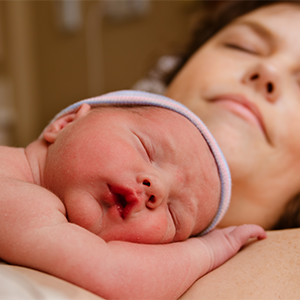Mother and baby skin-to-skin contact yields lasting benefits
March 26, 2018

A mother’s decision to plan ahead and advocate for skin-to-skin contact during the first hour of a newborn’s life yields benefits that could have lasting effects, according to the Centers for Disease Control and Prevention.
“The biggest benefits of skin-to-skin contact are mother and child bonding, the proven promotion of breastfeeding and the regulation of a newborn’s temperature and breathing,” says Julie Springer, M.D., an Obstetrician/Gynecologist with Northwest Women’s Consultants who is on staff at Northwest Community Healthcare (NCH).
Bonding
“When parents think of mother-baby, skin-to-skin contact, they usually think of the benefits of bonding,” says Dr. Springer. “Our NCH staff tries to promote skin-to-skin contact during the very important ‘golden hour,’ the first hour of a newborn’s life.”
Dr. Springer adds, “It doesn’t always have to be Mom either. If Mom is going through procedures of complications with delivery, Dad can also help with chest-to-chest, skin-to-skin contact. While baby will have to wait for Mom to breastfeed, this contact with Mom or Dad is most valuable throughout the first few days of life.”
A sweet moment
Dr. Springer recalls, “One of my patients needed to have a Caesarean section. While we were finishing up with Mom, the baby was immediately taken to the recovery area. After completing the surgery, I went to check on the baby and there was Dad with his shirt off, cuddling the newborn in Mom’s place. I think this was really sweet because as a couple, they had decided in advance this was important to them. Dad stepped in when Mom was not able.”
Breastfeeding
While we understand that breastfeeding doesn’t work for every mom, we do promote breastfeeding first because of the many benefits.
“At the start, putting the baby on the mother’s chest will start a sequence of natural events,” explains Dr. Springer. “First, the baby will move in such a way as if to do a baby walk towards the mother’s breast, which will start promoting early breastfeeding. This process stimulates the mother’s breast milk to come in. The sooner we get the baby on Mom’s breast, the sooner we can stimulate that milk to come in.”
Regulating temperature and breathing
Dr. Springer notes, “Because there is a lot of transitioning right after birth, babies sometimes breathe faster or their temperature is a little cooler. Traditionally, we would put them under a special heater, but now even better, when we immediately initiate skin-to-skin contact with Mom, the infant’s breathing begins to mimic Mom. In addition, the warmth of Mom’s skin can help bring up the baby’s temperature.”
This contact can actually prevent the baby from having to go to the neonatal intensive care unit (NICU) or the nursery.
Tender, customary practices
“Oftentimes, parents will come in for prenatal visits having read about the benefits of skin-to-skin contact, and wanting this to be a part of their delivery process,” adds Dr. Springer. “They are so happy to hear these are standard practices at NCH.”
Dr. Springer also notes, “Our Women and Infants’ Unit has made it a standard practice to delay cord clamping, as appropriate, and I think that has really helped with promoting skin-to-skin contact. This is a practice which varies from hospital to hospital.”
The American College of Obstetricians and Gynecologists recommends delayed umbilical cord clamping for all healthy infants for 30 to 60 seconds after birth, citing numerous benefits for newborns.
“Another tender practice at our hospital is that after every infant bath, our staff promotes skin-to-skin contact between mother and baby for that first hour after bathing,” says Dr. Springer.
Learn more about maternity services and the Women and Infants’ Unit at NCH.
Joeyband
“As part of our gentle transition initiative at NCH, we have introduced a snug-fitting wrap called the Joeyband, which cradles baby to mother, promoting skin-to-skin contact while also preventing newborn drops as mother adapts to holding her new baby,” says Nenette Cacal, D.N.P., M.S.N., RNC-OB, C-EFM, Clinical Nurse Manager at NCH.
“We have received positive feedback since we started using the Joeyband in January. Approximately 85 percent of new mothers choose to use the Joeyband during their stay,” adds Cacal.